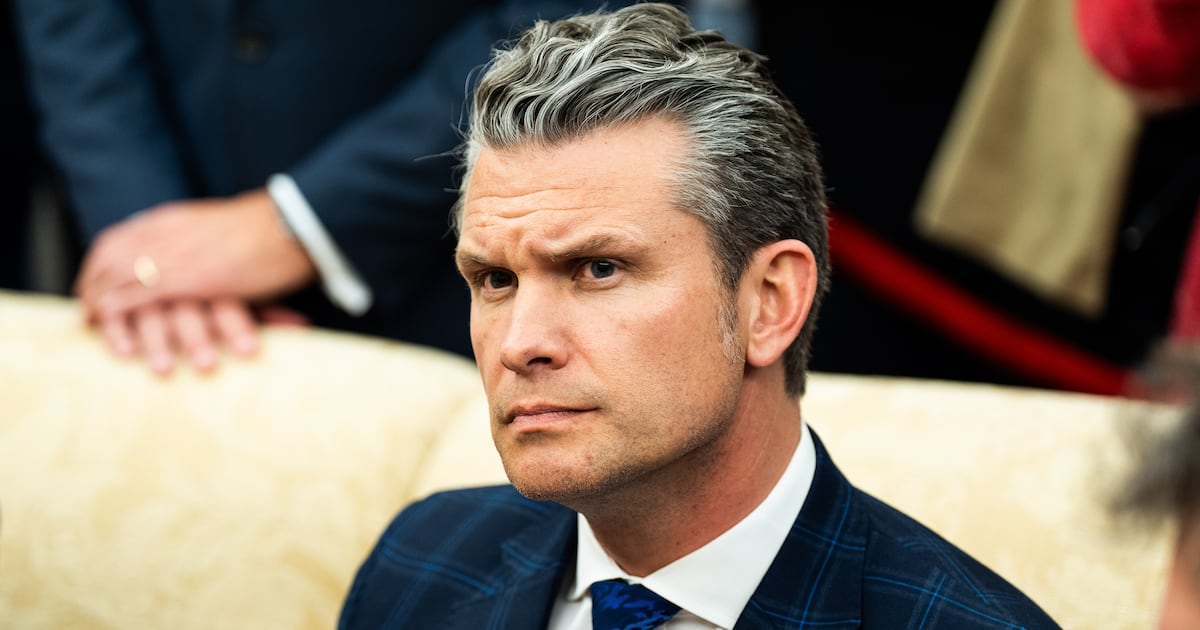Among the colorful poster art from the Women’s March protests, you may have seen the red-white-and-blue face of a Muslim-American woman wearing an American flag hijab--one of a series of inauguration-inspired “We the People” images by graphic artist Shepard Fairey, he of the Obama “Hope” poster fame.
Commissioned by the non-profit Amplifier Foundation, Fairey’s “We the People” posters were alluring visual representations of the resistance movement: a group of diverse people pushing back against the Trump administration’s fearmongering and racism.
Like most of his work, the posters were sold on his “Obey Giant” company website for $100 (some $900,000 proceeds were donated to the ACLU), though many of the artist’s original works have fetched upwards of $70,000 at auction.
Today, Fairey has launched a series of limited-edition skateboards in response to Trump’s first 100 days as president. Collaborating with the Skateroom, a San Francisco-based contemporary art brand, Fairey has turned his “No Future” artwork into a kind of skateboard triptych.
The Skateroom has also released three skate decks by Chinese dissident artist Ai Weiwei, showing Ai flashing his middle finger at the White House. The black-and-white “fuck you” to the Trump administration is part of a series of images of Ai flipping off various buildings and landmarks around the world.
Ai Weiwei, who was not available for an interview, said in a statement about the collaboration: “My favorite word is 'act'. I am partnering with the Skateroom for that very reason.”
Proceeds from Ai’s collaboration will go to Bridging Peoples, a non-profit charity in Turkey dedicated to combatting all forms of discrimination, and B’Tselem, an organization supporting human rights in Israeli-occupied territories.
“During the filming of Human Flow, my documentary on the global refugee condition, I had the opportunity to speak with individuals from both B'Tselem and the Bridging Peoples Association in Turkey,” Ai said. “What these two organizations do is very valuable to society, both in fighting against injustice and in helping those that are unfortunate.”
In a conversation over email, Fairey spoke with the Daily Beast about the meaning of “No Future,” the urgency to create art in the Trump era, and the artists calling for censorship of Dana Schutz’s “Open Casket” painting at this year’s Whitney Biennial.
DB: When did you first conceive “No Future” and what is the message you are trying to convey with this work? Is it an extension of your drive to “question everything”?
SF: The piece does fall within my philosophy of questioning everything, but there are more specific reasons for the image and text. I’m a big fan of wordplay and language in general, so a few of the ideas in the piece began percolating early in Trump’s bid for the presidency.
Inspired by lyrics from the Sex Pistols ("No Future") and the hubris of the early European inhabitants of what would become the United States that led to their belief that it was God’s will for them to conquer ocean to ocean, I think that what led largely to Trump’s election was the manifestation of the too-common mindset that facts don’t matter; in other words, “manifest destiny”—the truth will not penetrate the barriers of our ideology if the truth doesn’t sit well with our predispositions.
I come from punk rock so the Sex Pistols and their song “God Save the Queen” with the refrain “No Future” was a big protest anthem for me growing up. However, unlike the nihilism of “God Save the Queen” my use of “No Future” employs more of a bait and switch tactic. A lot of people felt defeated and hopeless by Trump’s election, but I feel his election should energize people to resist apathy, ignorance, sexism, xenophobia, and racism.
DB: Projecting a version of this image onto skate decks in collaboration with the Skateroom is, in a way, a return to your early works as an artist—art that is intended to go on “four wheels or a wall,” as you put it. You've also said that “the spirit of skateboard culture is what drives this collaboration.” How do you define the “spirit of skateboard culture,” and how does that spirit interact with or heighten the message of “No Future”?
SF: Skateboarding has always been and continues to be creative and rebellious. Art and design are an extremely important part of skateboard culture, even if it’s not recognized by the more elitist or pretentious members of the art world. Skateboarding itself requires creative adaptation to the streets and obstacles. My background as a skateboarder helped me to be a better street artist because I was already conditioned to look at the terrain opportunistically.
Skateboarders tend to call bullshit on things more quickly than most, and I think the love of rebellious music, whether it be punk, hip-hop, or reggae is another manifestation of that creative and rebellious culture. Placing my art within that culture makes a lot of sense for me because skateboarders are not afraid to go against the grain, which I think is especially important in rejecting and resisting the agenda of the current administration.
DB: “No Future” is darker than the images from your “We the People” campaign. Are you trying to convey a sense of urgency? To satirize the fearmongering that Trump has thrived on? To reflect the threats to democracy we’ve seen in Trump’s first 100 days as president?
SF: “No Future” and “We The People” are two sides of the same coin. In my work, I frequently want to celebrate things that are positive such as diversity and human dignity in the case of “We The People” while I’ve also taken the approach of criticizing unjust and poor behavior as a way of suggesting that those behaviors are the wrong course and should not be normalized. I try to find a balance between positivity and negativity, celebration and critique in my work; I think there is room for both.
DB: As an artist motivated by political and social activism, do you feel a sense of urgency to create more in our current political climate, especially given the Trump administration’s desire to eliminate the National Endowment for the Arts?
SF: I’m always making art about social and political issues, but yes, I feel an urgency to address problems that have been created or at least exacerbated by the current administration. I’m all for the NEA but to be honest, I consider defunding the NEA one of the smallest problems we’re now facing.
There are too many bad policy choices to go into that are being pushed by the Trump Administration, but the relaxation of environmental regulations and corporate and banking regulations alone are enough to keep me busy and should be a big concern for every citizen who isn’t a billionaire and likes to breathe air.
DB: You were galvanized by Obama’s 2008 campaign, but were you as motivated to create art during the Obama years as you are now?
SF: I was. Obama was inspiring as a candidate but was met with a lot of partisan opposition and hostility which prevented forward motion on a lot of the things that I agreed with him on. I made art about several of those issues like the unfortunately compromised nature of healthcare reform.
I also disagreed with Obama on issues like drone warfare and domestic surveillance, which I also made art about. The social and political issues the world faces are bigger than a few leaders. I made a lot of work about corporate influence in government, which is a problem in both parties and under any president.
DB: Your work has frequently targeted Republican administrations (the George W. Bush-as-vampire piece, for instance) and conservative ideology. What do you make of criticism of far-left movements on college campuses and the idea that they’re embracing illiberalism?
SF: Free speech is important whether you like what’s being said or not. The reason why it’s so important is that the entire spectrum of ideas needs to be heard so that the best ones are embraced and rise to the top. If you’re a liberal and don’t like conservative speech and you try to stifle that conservative speech, you need to be prepared for your own progressive speech to be stifled when the power shifts out of your favor.
I might be botching this quote but I agree with the idea that a measure of society is not how it treats its most powerful but how it treats its most vulnerable, including the poor and incarcerated and—I would add to that—the people whose ideas are not currently in favor.
DB: Do you think that the Whitney Museum should have heeded artists’ calls to remove Dana Schutz’s “Open Casket” painting. [The painting is of a photograph taken of Emmett Till—the black teenager brutally murdered by two white men in 1955—when he was lying in his open casket. Some activists called for the painting to be taken down and destroyed, because it was “not acceptable for a white person (Schutz) to transmute Black suffering into profit and fun.”]
SF: I don’t think that the painting should come out of the Whitney Biennial, I agree with the rationale of the curators. Art is not always meant to be decorative or soothing, in fact, it can create uncomfortable conversations and stimulate uncomfortable emotions.
I don’t agree with most forms of censorship, and I especially don’t agree with the idea that one needs to be from the same cultural, ethnic, or religious background as the subjects they portray in order to be qualified to portray those subjects. I believe that compassion and empathy should cross all of those category barriers, and the conversations art creates can be inflammatory initially, but I think are most often constructive and healing in the long run.
Shepard Fairey’s limited edition, 450 hand screen-printed skateboards are available exclusively on Skateroom’s website for $450 each. Ai Weiwei’s limited edition, 666 hand screen-printed skateboards are also available exclusively on the Skateroom’s website. The first 66 will be signed by the artist and priced at $3,000 each.





